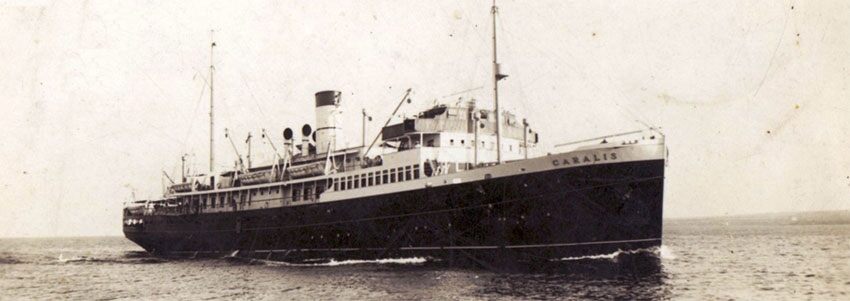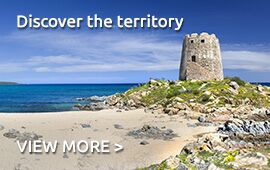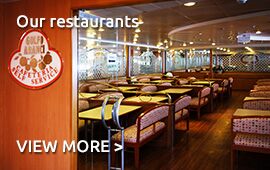The history of Tirrenia

1936
On December 21st, after the founding of Finmare and the project of rationalization of the shipping services by the Italian State, in Naples, it was born Tirrenia, Società Anonima di Navigazione, located inside Palazzo Caravita di Sirignano. The initial task is to provide passengers and freight services in the areas of the Tyrrhenian Sea, North Africa and the western Mediterranean, exploiting a fleet of 55 units, from the existing shipping companies fleet.
1940
Eleven new Foscolo Class ships become part of Tirrenia fleet, but, due to the outbreak of World War II, the distance and the routes number was drastically reduced, while the best ships were allocated to military service.
1942
Eight of the eleven Foscolo Class ships were commissioned but, as the war progressed, Tirrenialost more than 50 units, almost the entire fleet, and then most of the routes were suspended. The surviving ships were the Città di Alessandria, the Città di Tunisi, the Città di Marsala (declared war booty by the Yugoslavian Government), the Giosuè Borsi (whose construction began during the war), the Argentina and the small steamers Capo Sandalo and Gallura.
1946
After the war, the Company became a public limited company and changed its name to Tirrenia di Navigazione S.p.A.. The activities on the Civitavecchia-Olbia route resumed through the ships Città di Alessandria and the Città di Marsala which, after two years, was renamed Città di Trapani in memory of another unit sunk during the war. During this period, the few remaining cargo ships were converted to passenger ships and the United States granted the use of the Charles Hull Ship, renamed Marechiaro.
1947
Some important measures were taken in consequence to the events of the war: the search for sunken ships, to retrieve, to repair and put them back into service. Such operations were carried out for the steamers Ichnusa, Limbara and the ships Rossini, Verdi and Alfredo Oriani, renamed as the Città di Messina, Cagliari and Celio respectively. In the shipbuilding yards in Naples a new vessel called Olbia was build.
1948 - '49
In July 1948 Tirrenia bought the ship Lazzaro Mocenigo, later renamed Civitavecchia and used on the Genoa-Porto Torres route. Three months later the steamer Torres was retrieved and placed on the same route. The last ship recovered was the Città di Savona which sank in February 1944, which returned to the fleet in November 1949 with a capacity of 135 passengers and with the name of Città di Livorno. According to the Sales Act of the United States, Triennia could benefit of three Liberty Class steamers, renamed Napoli, Firenze and Milano. In order to meet the increasing demands of transportation, Tirrenia hired some of the steamers of Società di Navigazione d'Amico and Lloyd Triestino.
1951 - '52
The fifties marked the end of the reconstruction and the beginning of the expansion of Tirrenia, by restoring the previously abandoned route: the commercial line for Northern Europe was reactivated and the five units of Region Class (Sicilia, Sardegna, Calabria, Lazio, Campania Felix), capable of carrying 568 passengers each, were commissioned to Castellammare di Stabia and Palermo Shipyards. The Città of Tunisi was modernized and commissioned in May 1952. Since 1952 the routes to Benghazi had been restored by the Città di Trapani and to Spain, by the ships Città di Alessandria, Città di Messina and Celio. The vessels Cagliari and Giosuè Borsi were used on the route to Northern Europe, replacing the previous hired steamers. Also in '52 the new Region Class ships were commissioned also on the Civitavecchia-Cagliari route.
1954 - '55
In these years Olbia and Civitavecchia units were divested, replaced by the Città di Livorno and the Città di Alessandria ships.
1958
The new vessel Torres, with a capacity of 572 passengers, was included on the Genoa-Porto Torres route. Three ships of U.S. origin Liberty Class were sold to some Italian entrepreneurs.
1959
Some Region Class ships were moved on the Genoa-Porto Torres route that was becoming increasingly important as regards the economic point of view.
1960 - '63
The Italian economic boom, the migration from the islands to the north of the peninsula and the important phenomenon of mass motorization, represented concrete aspects of a real challenge for Tirrenia. Olbia was purchased and the two City Class sister ships which entered into service on the Civitavecchia-Olbia route, were delivered. For the first time the ships were equipped with a garage for the cars transport: in 1963, the first conversion works on the Città di Alessandria, on which boxes with side doors were built, were performed.
1965
Works began with the transformation into ferries of the first four Region Class units. This was not enough to cope with the influx of passengers with cars therefore Tirrenia commissioned to Fincantieri the production of a first set of real ferries, the Poet Class. They were called: Carducci, Petrarca, Leopardi, Manzoni, Pascoli, Boccaccio, Verga and Deledda, eight sister ships capable of carrying up to a thousand passengers, about three hundred cars, all equipped with small cabins and the possibility to carry dozens of trucks. Four small ferries for the connections between Sardinia and the smaller islands were also delivered.
1970
The seventies were characterized by the expansion of freight transport, by certain changes within the organization and a continuous renewal of the fleet. The Poet Class ships saw the entry of Boccaccio, in service from 8th June 1970 on the Genoa-Porto Torres route, followed by Carducci, Manzoni, Pascoli, Leopardi and Petrarca.
1971 - '72
In these years almost all the ships returning from the Second World War were sold and demolished: the Città di Livorno, Alessandria, Tripoli, Tunisi, Olbia and the steamers Ichnusa, Campidano, Belluno and Marechiaro. In 1972 it was the turn of the cities of Messina, Celio and Campania Felix.
1974
The commercial line for Northern Europe with the ships Cagliari, Giosuè Borsi and Vallisarco, came under the control of Società Adriatica di Venezia. Tirrenia bought two cargo ferries from Linea Canguro S.p.A.: the Staffetta Adriatica e the Staffetta Tirrenica.
1975 - '76
Tirrenia established three new divisions: the Caremar, Siremar and Toremar. In the same year it was bought the Malta Express ferry of 1.600 passengers and 250 cars, and two other ferries were hired. The Arborea was sold to the island of Cipro, while the old Cagliari, Giosuè Borsi and the latest Torres were laid up.
1977 - '78
There was another important and growing expansion of the sea freight section and a considerable renewal of the Sardinian Regional fleet, also thanks to the purchase of the small ferries Carloforte and Limbara. In Castellammare di Stabia the last two ships of Poet Class, Deledda and Verga, for the Civitavecchia-Olbia route were built, replacing the two ships of City Class built in the Fifties.
1979
The Staffetta Class was created after the purchase of three ships of the same type called Staffetta Mediterranea, Staffetta Ligure and Staffetta Ionica, capable of carrying 117 semi-trailers.
1980
In the early 80s the fleet was enhanced with six new vessels, the Strade Consolari Romane. Each ferry could carry 1.400 passengers and 400 cars. In order to cope with the continuous increase in the summer traffic to Sardinia, Tirrenia used merchant ships, which were put alongside passenger vessels, in order to increase cars transport capacity and to guarantee the commercial traffic.
1986
Tirrenia built two new ferries for the Sardinia regional transport: the isle of Caprera and Ichnusa. Towards the end of the year, the Strade Romane were further elongated with a central section and got an additional bridge, in order to increase the capacity of the vehicles and passengers transport.
1987
The last regional division, the Saremar was constituted. To support the high demand for passengers transport, cargo ships of Staffetta Class were converted into Ro–Pax.The Social Class was born and its ships were renamed Caralis, Torres and Arborea. In the same year, the old City Class units were demolished.
1988
Tirrenia further consolidated the freight lines purchasing the units Apulia, Torre del Greco, Adria and Julia. The first three ships were also adapted to carry passengers and formed the Head Class,while the latter was renamed Campania. Later Tirrenia bought from Adriatica di Venezia two other cargo ferries: Calabria and Sicily which will complete the Calabria Class..
1990 - '93
The early nineties were characterized by an important and substantial restyling of lots of ferries: on the Leopardi new car bridges were built, while the other Poeta ships were equipped of four decks and bulges. The same operations were applied on three units of the Roman Roads Class, renamed Transformed Roman Roads. In recent years, a new generation of ferries has become operative too: the High Speed Craft. In 1993 the first unit of Aquastrada Class TMV 101, the Guizzo, was commissioned. It was a ferry capable of carrying 450 passengers and 120 cars at a speed that was more than twice the one of the other ferries in the fleet (40 knots). The following year it was the turn of its sister ship called Scatto.
1994
The ferries Toscana, Lazio and Puglia were commissioned. The units belonging to the Poet Class were gradually disarmed and sold.
1996
The unit Toscana was transformed into a Ro-Pax ferry which could carry both freight and passengers.
1997
The year 1997 was an important year, as the Viamare company was incorporated and a lot of ships were unarmed, such as the Capo Carbonara, the Capo Sandalo, Carducci, Boccaccio, Petrarca, Pascoli and Manzoni.
1998 - '99
The five Poet Class ships were sold and four new highspeed ferries, which were part of the Jupiter MDV 3000 Class, were commissioned: Aries, Taurus, Capricorn and Scorpio, with a capacity of 1.800 passengers and 450 cars and with a top speed of over 40 knots.
1999 - 2005
Seven new units, which gradually replaced the old ferries, joined Tirrenia fleet. From 1999 to 2001 the Vincenzo Florio Class units, equipped with a high cargo and passengers capacity, were operative on the routes to Sicily. From 2001 to 2003 it was the turn of Bithia Class units (Bithia, Janas, Athara), capable of carrying 2.700 passengers and 900 cars, and travelling up to 30 knots speed. From 2004 to 2005 the Nuraghes Class ships (Nuraghes and Sharden) were commissioned. They were similar to the Bithia class, but with a greater freight capacity. The Bithia and Nuraghes units were used on the routes to Sardinia.
2008 - 2011
During these years, the hypothesis, and then the subsequent realization of a progressive privatization of the company, began to take shape, starting with the regional companies related to it, without neglecting the importance of the service provided by the company. On 6th November 2008 the Council of Ministers of the fourth Berlusconi government gave the privatization of Tirrenia di Navigazione S.p.A. the go-ahead. On November 3rd 2009, an agreement between the Transport Minister Matteoli and the regions concerned, allowed the latter to control the regional maritime societies: the Ca.re.mar was given to Campania, the Sa.re.mar to Sardinia and the To.re.mar to Tuscany. On May 19th 2011 the second tender for the privatization of Tirrenia ended, won by Compagnia Italiana di Navigazione (CIN), a new company formed by Moby, Clessidra, Negri and Izzo.
2012
The official date of privatization was June 21st 2012. On July 16th 2012, the New Tirrenia signed the agreement with the Ministry of Industry and Transport according to which the Company became the owner of the public service connecting the large islands: Sardinia, Sicily and the Tremiti Islands. On July 19th 2012, with the official signing of the closing of the transaction, CIN became the new owner of Tirrenia.
Always in this year two new ships were used for the route Cagliari-Civitavecchia: Bonaria and Amsicora while the Roman Roads Class ships were no more operative. In November 2012 the ships Toscana and Lazio were sold.
2013
Since January, the ship Dimonios, had been used on the routes Cagliari-Naples, Cagliari-Palermo and Cagliari-Trapani. The Diminios completed the renovation of the Tirrenia fleet which worked for Sardinia.
In May, the ships Bithia, Athara, Nuraghes, Sharden, Florio and Rubattino were subjected to an intensive program of modernization of the interiors, with the reutilization of all the common areas, the restoration of the cabins and the creation of new entertainment areas for the children and new spaces for the refreshment and the entertainment.
2014
In December Tirrenia left the historic office of Rione Sirignano and moved to Calata Porta di Massa, Interno Porto.
2015
Nel luglio di quest’anno il 100% di Tirrenia passa sotto il controllo del Gruppo Armatoriale che fa capo alla Famiglia Onorato.


